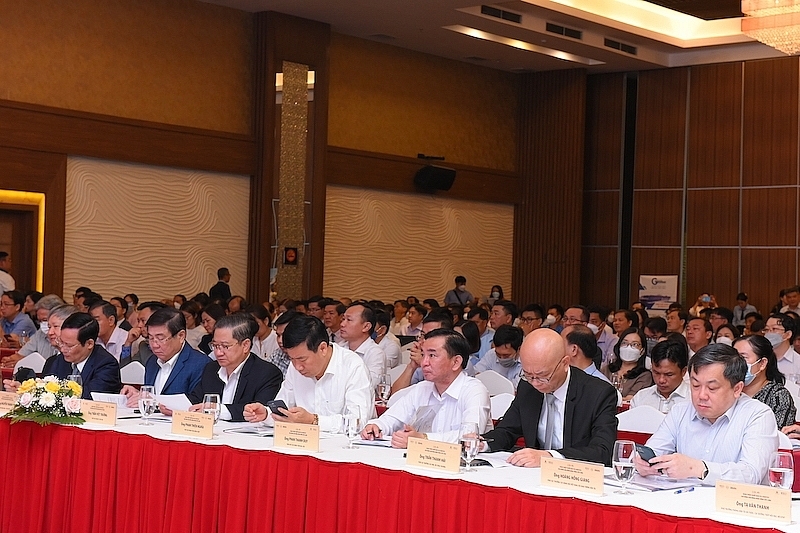Removing bottlenecks in logistics costs in the Mekong Delta
On May 27, at the Forum: "Improving the logistics service chain for agricultural products in the Mekong Delta", delegates said that the Mekong Delta has the highest logistics costs, accounting for 30% of the product cost, and so it is necessary to remove this bottleneck to help businesses develop.
 |
|
Delegates proposed many solutions to remove logistics bottlenecks |
The highest logistics costs in the country
Pham Tan Cong, Chairman of the Vietnam Confederation of Trade and Industry (VCCI), said that, as the country's largest food, seafood, fruit production and export region, Mekong Delta contributes about 50% of rice production, 95% of rice exports, nearly 65% of aquaculture production, 60% of fish exports and nearly 70% of fruits of the whole country.
However, logistics costs in the Mekong Delta are a burden to the competitiveness of products manufactured in the region. According to statistics of the Ministry of Industry and Trade, logistics costs in the Mekong Delta account for 30% of product costs.
“The main cause of this bottleneck, which experts estimate, is the lack of linkages and synchronization in the logistics system in the Mekong Delta. The seaport system is still lacking, especially a deep-water port for shipping containers. Cargo transportation is mainly by road and inland waterways, while the situation of some key ports in the East is often overloaded, leading to increased service fees, warehousing, and waiting time." Pham Tan Cong said.
According to statistics of the Vietnam Logistics Business Association (VLA), the 13 provinces of the Mekong Delta only 1,461 logistics service providers, accounting for about 4.39% of the number of logistics enterprises in the country. In particular, enterprises providing professional logistics services are very limit ed and are mainly agricultural enterprises. This increases costs for businesses, reduces the competitiveness of agricultural products in the Mekong Delta in particular and Vietnamese agricultural products in general.
Despite owning an extremely dense system of canals, the Mekong Delta cannot form an inland waterway transport route due the differences in inland waterway stles. The barges are also unable to carry the maximum allowable load due to the limit ation of the static height of the bridges serving road traffic, so barge tonnage is only from 1,500 tons to 3,500 tons. Most import and export goods have to be trans-shipped through Cat Lai ports in Ho Chi Minh City and Cai Mep-Thi Vai of Ba Ria - Vung Tau, which takes a lot of time and has a high cost, affecting the competitiveness of goods in the market.
In addition, the Mekong Delta still lacks key logistics centers and satellite systems, empty container yards, warehouse systems at ports, and standard irradiation and food safety inspection units. .
Removing the bottleneck
Assessing the development potential of the Mekong Delta, Nguyen Thanh Phong, Deputy Head of the Central Economic Commission, said that the Mekong Delta is the largest agricultural production center of the country. On February 28, 2022, the Prime Minister issued Decision No. 287/QD-TTg approving the Master Plan for the Mekong Delta in the period of 2021 - 2030, with a vision to 2050. The master plan sets out development goals for the Mekong Delta region.
By 2030, to become a sustainable, dynamic and highly efficient agricultural economic center of the country, region and the world on the basis of developing a system of focal centers on agriculture, economic corridors and dynamic cities with diversified services and industries with synchronous infrastructure systems, adaptive to climate change.
To achieve the above goals, according to Nguyen Thanh Phong, the first breakthrough is the development of a synchronous logistics infrastructure system, a multi-modal transport system connecting inter-regional and international, in which focuses on promoting the region's strengths in inland waterway navigation. By 2030, investment in building and upgrading about 830 km of expressways; about 4,000 km of national highways; 4 airports; 13 seaports, 11 clusters of passenger ports and 13 clusters of inland waterway cargo ports.
At the seminar, experts and businesses also proposed many solutions to remove bottlenecks and reduce logistics costs in transporting goods for the Mekong Delta.
According to Nguyen Phuong Lam, Director of VCCI Can Tho, it is expected that in the next 3-5 years there will be a smooth highway from Ho Chi Minh City to Can Tho, Ca Mau and Chau Doc (An Giang); the Dinh An channel will be dredged; and a center for production, processing and consumption of agricultural products in the Mekong Delta was formed. That will be the second "golden opportunity" for the Mekong Delta in the past two decades, especially for the logistics and port industry to make a breakthrough.
The Mekong Delta will also be promoted through a system of eight airports, namely Tan Son Nhat, Can Tho, Phu Quoc, Buon Ma Thuot, Lien Khuong, Rach Gia, Con Dao and Ca Mau. This airport system not only helps to perfect the logistics system for the Mekong Delta, but also helps promote tourism for the region, thereby supporting the development of consumption of regional products.
In order to develop the Mekong Delta's economy, it is necessary to take advantage of the source of agricultural products, focusing on strengthening regional linkages and facilitating trade in products, to help the region's economy develop faster than the inherent advantage. In particular, it is necessary to have effective plans, policies and models, connecting the comprehensive supply chain for Vietnamese agricultural products from production - harvesting to customs clearance - export, towards optimizing logistics costs, increasing competitive advantages for agricultural products, creating sustainable output for agricultural products.










